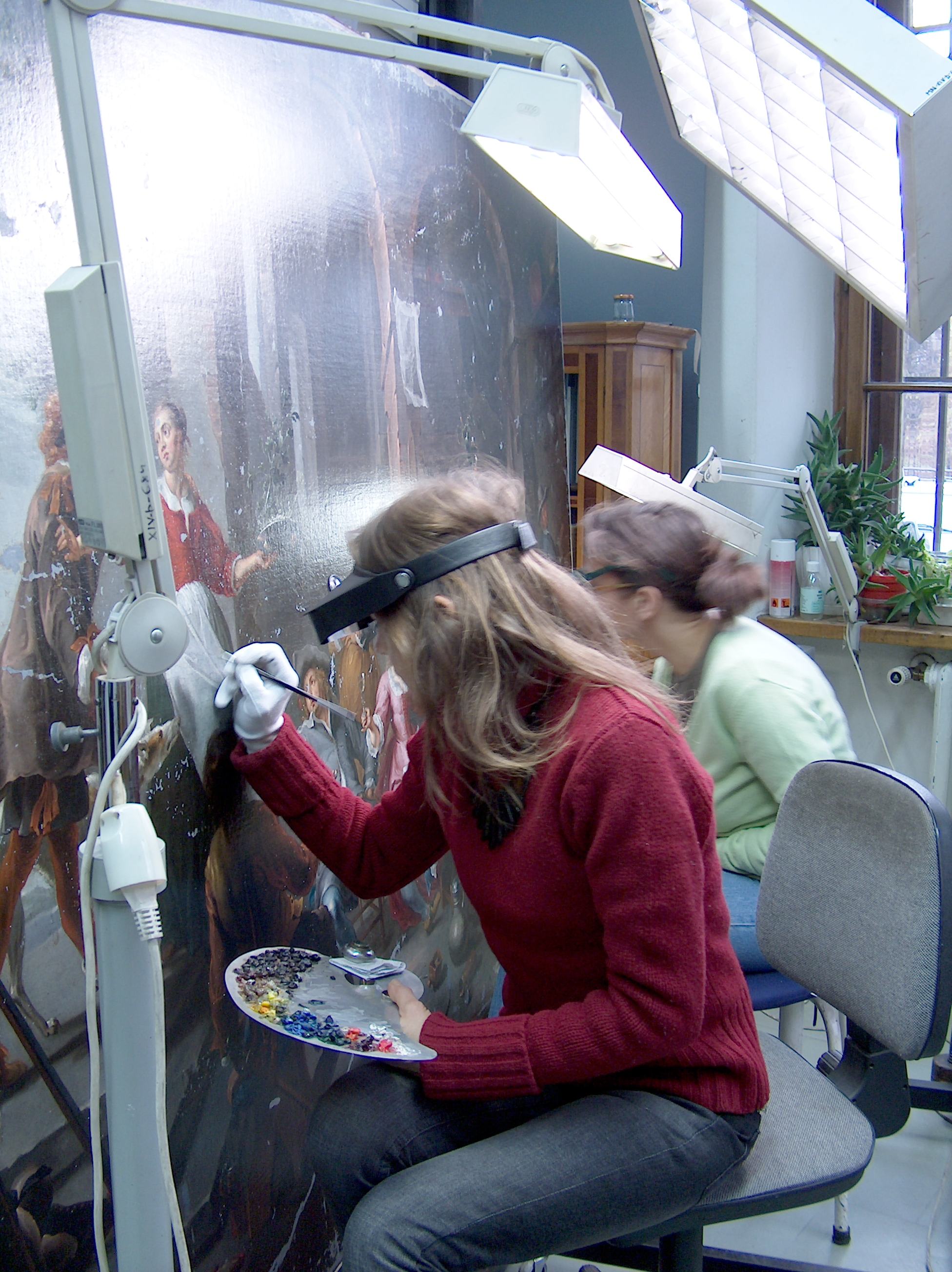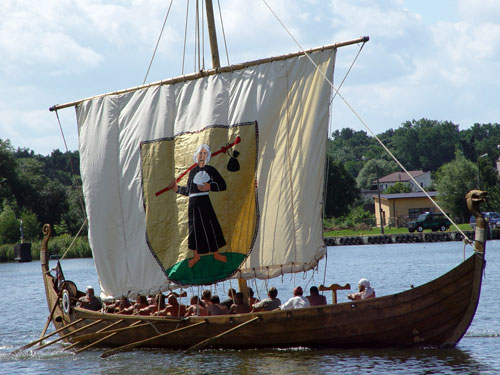|
Ladby Ship
The Ladby ship is a major ship burial at the village of Ladby near Kerteminde in Denmark. It is of the type also represented by the boat chamber grave of Hedeby and the ship burials of Oseberg, Borre, Gokstad and Tune in South Norway, all of which date back to the 9th and 10th centuries. It is the only ship burial from the Viking Age discovered in Denmark (Hedeby was a Danish Viking settlement, but today is located in Germany). It has been preserved at the site where it was discovered, which today is part of a museum. Discovery The grave is situated within an otherwise unremarkable burial site from the Viking Age. Excavations revealed an abundance of grave goods consisting of both objects and animals. It has been dated to the early 10th century, based on a gilded link of bronze for a dog-harness, decorated in the Jelling style, found there. . The grave had been extensively damaged. Since only a few small human bones were found, researchers have concluded that the site is ... [...More Info...] [...Related Items...] OR: [Wikipedia] [Google] [Baidu] |
Conservator-restorer
A conservator-restorer is a professional responsible for the preservation of artistic and cultural artifacts, also known as cultural heritage. Conservators possess the expertise to preserve cultural heritage in a way that retains the integrity of the object, building or site, including its historical significance, context and aesthetic or visual aspects.Defining the Conservator: Essential Competencies. (2003). Retrieved from http://www.conservation-us.org/docs/default-source/governance/defining-the-conservator-essential-competencies.pdf. This kind of preservation is done by analyzing and assessing the condition of cultural property, understanding processes and evidence of deterioration, planning collections care or site management strategies that prevent damage, carrying out conservation treatments, and conducting research.Careers in Conservation. (2014). Retrieved from http://www.conservation-us.org/publications-resources/careers-in-conservation/become-a-conservator#.VPPIxMaLTwN ... [...More Info...] [...Related Items...] OR: [Wikipedia] [Google] [Baidu] |
Viking Ship Burials
Vikings ; non, víkingr is the modern name given to seafaring people originally from Scandinavia (present-day Denmark, Norway and Sweden), who from the late 8th to the late 11th centuries raided, pirated, traded and settled throughout parts of Europe.Roesdahl, pp. 9–22. They also voyaged as far as the Mediterranean, North Africa, Volga Bulgaria, the Middle East, and North America. In some of the countries they raided and settled in, this period is popularly known as the Viking Age, and the term "Viking" also commonly includes the inhabitants of the Scandinavian homelands as a collective whole. The Vikings had a profound impact on the early medieval history of Scandinavia, the British Isles, France, Estonia, and Kievan Rus'. Expert sailors and navigators aboard their characteristic longships, Vikings established Norse settlements and governments in the British Isles, the Faroe Islands, Iceland, Greenland, Normandy, and the Baltic coast, as well as a ... [...More Info...] [...Related Items...] OR: [Wikipedia] [Google] [Baidu] |
Ships Preserved In Museums
There are numerous notable ships preserved in museums around the world. These are distinct from museum ships, which are ships where visitors can go aboard to see the ship. List This list is in date order, starting with the oldest ships. * Khufu ship: Ancient Egyptian ship (around 2500 BC) sealed in the Great pyramid of Giza on display at the Giza pyramid complex * Dover Bronze Age Boat: remains of Bronze Age sewn plank boat preserved at the Dover Museum, England * Lurgan Canoe: early bronze age oak canoe (around 2000 BC) found in Galway on display at the National Museum of Ireland. Longest dugout canoe ever found * Uluburun shipwreck: Bronze Age fragments of ship with cargo at the Bodrun museum, Turkey * Nemi ships: Caligula's Roman ships, destroyed by fire in 1944 * Tune ship: late 9th- or early 10th-century Viking ship from a ship burial, preserved at the Viking Ship Museum (Oslo) * Gokstad ship: 9th-century Viking ship from a ship burial, preserved at the Viking Ship Mu ... [...More Info...] [...Related Items...] OR: [Wikipedia] [Google] [Baidu] |
Archaeological Discoveries In Denmark
Archaeology or archeology is the scientific study of human activity through the recovery and analysis of material culture. The archaeological record consists of Artifact (archaeology), artifacts, architecture, biofact (archaeology), biofacts or ecofacts, archaeological site, sites, and cultural landscapes. Archaeology can be considered both a social science and a branch of the humanities. It is usually considered an independent academic discipline, but may also be classified as part of anthropology (in North America – the four-field approach), history or geography. Archaeologists study human prehistory and history, from the development of the first stone tools at Lomekwi in East Africa 3.3 million years ago up until recent decades. Archaeology is distinct from palaeontology, which is the study of fossil remains. Archaeology is particularly important for learning about prehistoric societies, for which, by definition, there are no written records. Prehistory includes ove ... [...More Info...] [...Related Items...] OR: [Wikipedia] [Google] [Baidu] |
Viking Ships
Viking ships were marine vessels of unique structure, used in Scandinavia from the Viking Age throughout the Middle Ages. The boat-types were quite varied, depending on what the ship was intended for, but they were generally characterized as being slender and flexible boats, with symmetrical ends with true keel. They were clinker built, which is the overlapping of planks riveted together. Some might have had a dragon's head or other circular object protruding from the bow and stern for design, although this is only inferred from historical sources. Viking ships were used both for military purposes and for long-distance trade, exploration and colonization. In the literature, Viking ships are usually seen divided into two broad categories: merchant ships and warships, the latter resembling narrow "war canoes" with less load capacity, but higher speed. However, these categories are overlapping; some transport ships would also form part of war fleets. As a rule, ship lanes in Scandin ... [...More Info...] [...Related Items...] OR: [Wikipedia] [Google] [Baidu] |
Picture Stone
A picture stone, image stone or figure stone is an ornate slab of stone, usually limestone, which was raised in Germanic Iron Age or Viking Age Scandinavia, and in the greatest number on Gotland.The article ''Bildstenar'' in ''Nationalencyklopedin'' (1990).Hadenius, Stig; Nilsson, Torbjörn; Åselius, Gunnar (1996) ''Sveriges historia: vad varje svensk bör veta''. Bonnier Alba, Borås. p. 28. More than four hundred picture stones are known today.A presentation at the County Museum of Gotland. All of the stones were probably erected as memorial stones, but only rarely beside graves. Some of them have been positioned where many people could see them at bridges and on roads. They mainly differ from |
Norse Mythology
Norse, Nordic, or Scandinavian mythology is the body of myths belonging to the North Germanic peoples, stemming from Old Norse religion and continuing after the Christianization of Scandinavia, and into the Nordic folklore of the modern period. The northernmost extension of Germanic mythology and stemming from Proto-Germanic folklore, Norse mythology consists of tales of various deities, beings, and heroes derived from numerous sources from both before and after the pagan period, including medieval manuscripts, archaeological representations, and folk tradition. The source texts mention numerous gods such as the thunder-god Thor, the raven-flanked god Odin, the goddess Freyja, and numerous other deities. Most of the surviving mythology centers on the plights of the gods and their interaction with several other beings, such as humanity and the jötnar, beings who may be friends, lovers, foes, or family members of the gods. The cosmos in Norse mythology consists of Ni ... [...More Info...] [...Related Items...] OR: [Wikipedia] [Google] [Baidu] |
Funen
Funen ( da, Fyn, ), with an area of , is the third-largest island of Denmark, after Zealand and Vendsyssel-Thy. It is the 165th-largest island in the world. It is located in the central part of the country and has a population of 469,947 as of 2020. Funen's main city is Odense, which is connected to the sea by a seldom-used canal. The city's shipyard, Odense Steel Shipyard, has been relocated outside Odense proper. Funen belongs administratively to the Region of Southern Denmark. From 1970 to 2006 the island formed the biggest part of Funen County, which also included the islands of Langeland, Ærø, Tåsinge, and a number of smaller islands. Funen is linked to Zealand, Denmark's largest island, by the Great Belt Bridge, which carries both trains and cars. The bridge is in reality three bridges; low road and rail bridges connect Funen to the small island of Sprogø in the middle of the Great Belt, and a long road suspension bridge (the second longest in the world at the tim ... [...More Info...] [...Related Items...] OR: [Wikipedia] [Google] [Baidu] |


.jpg)

